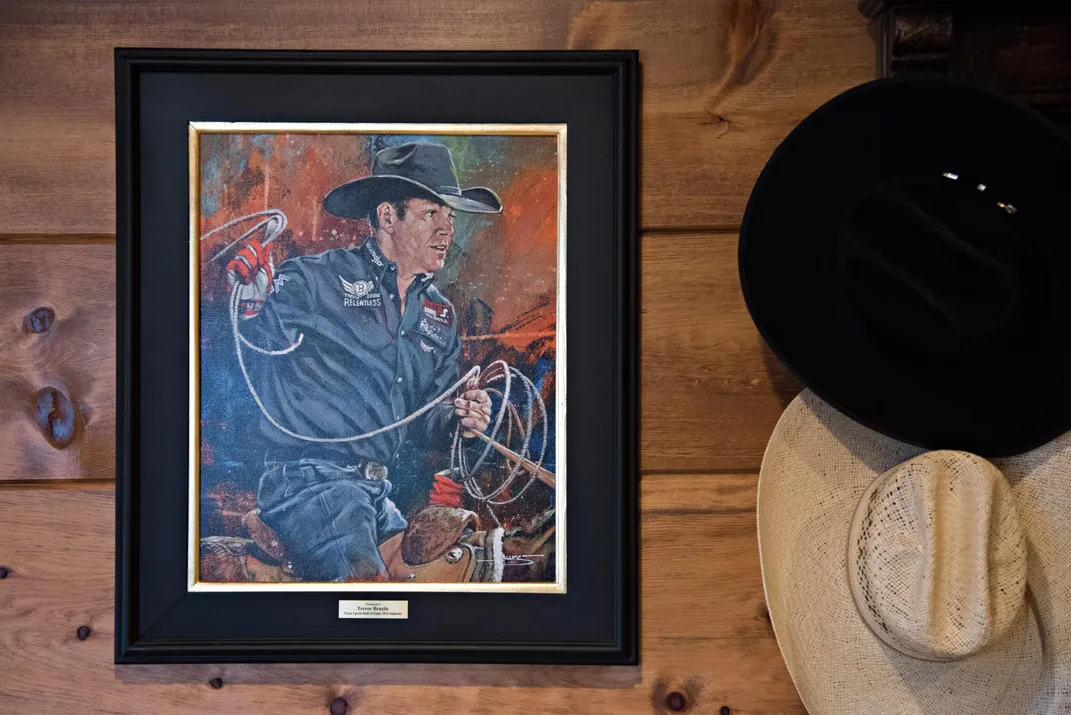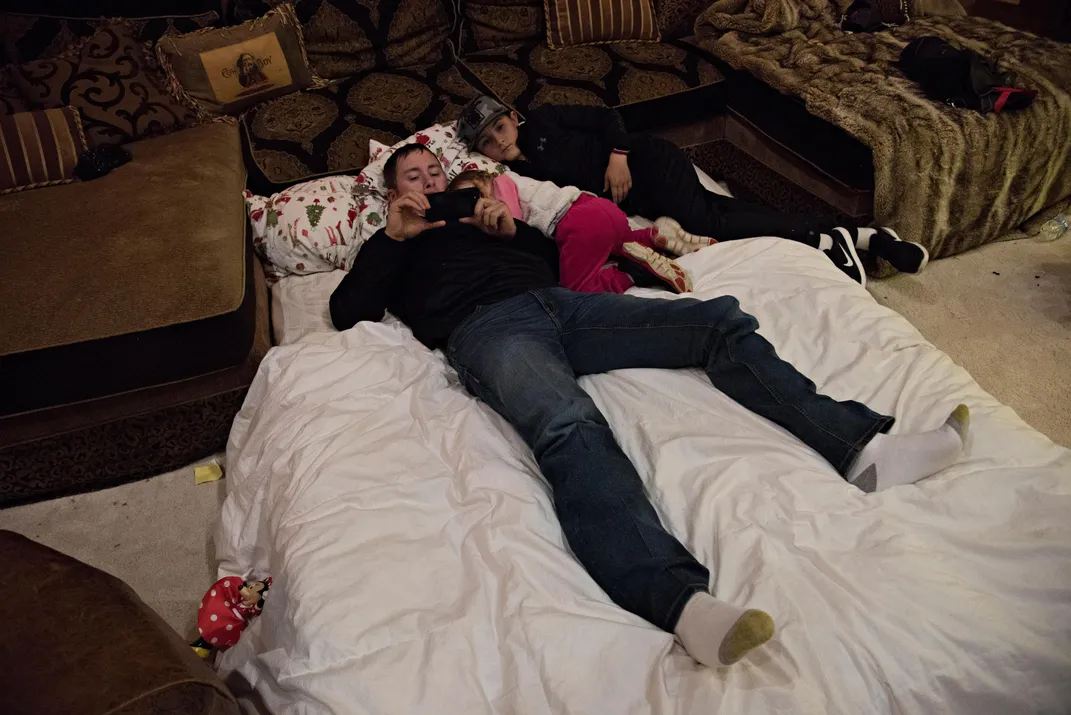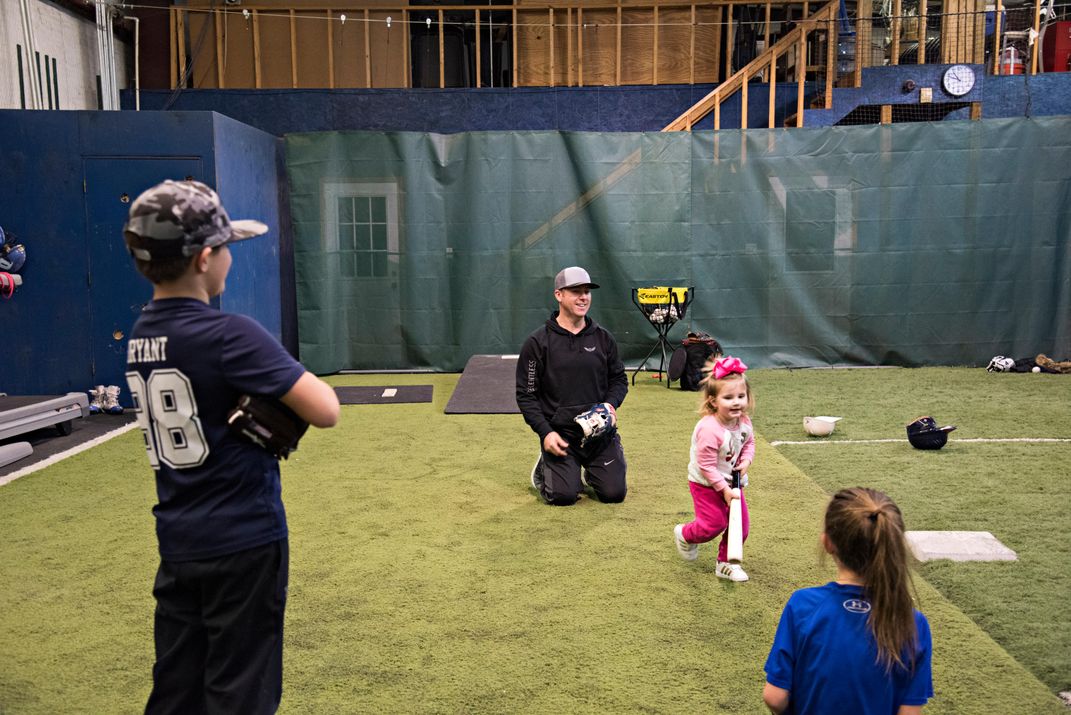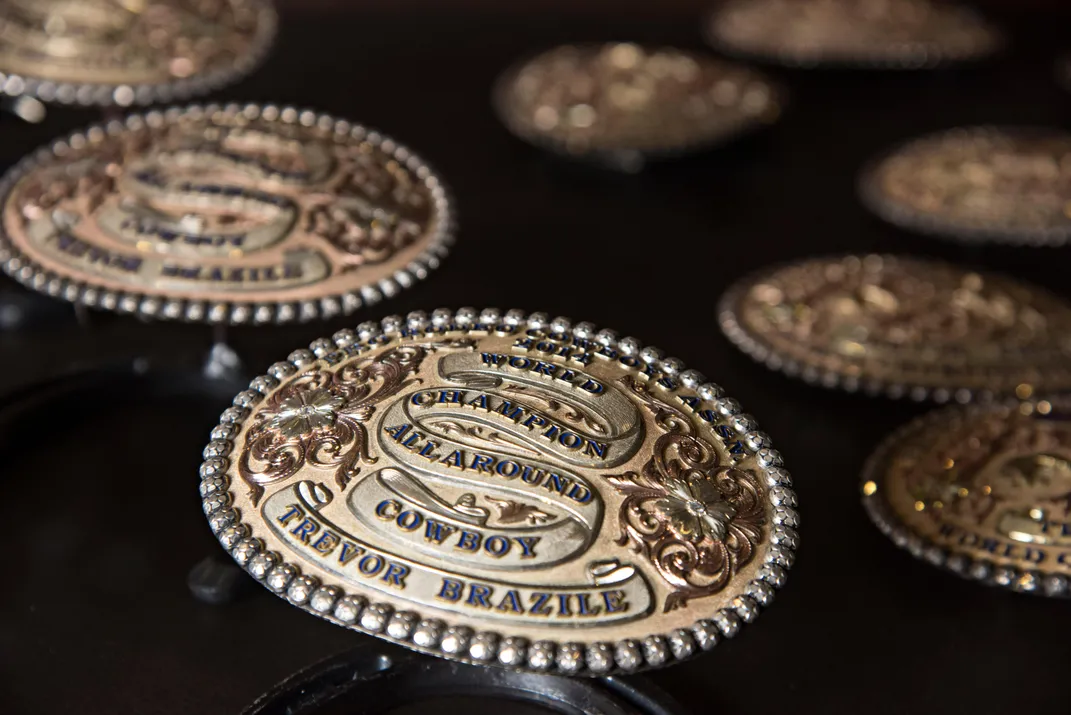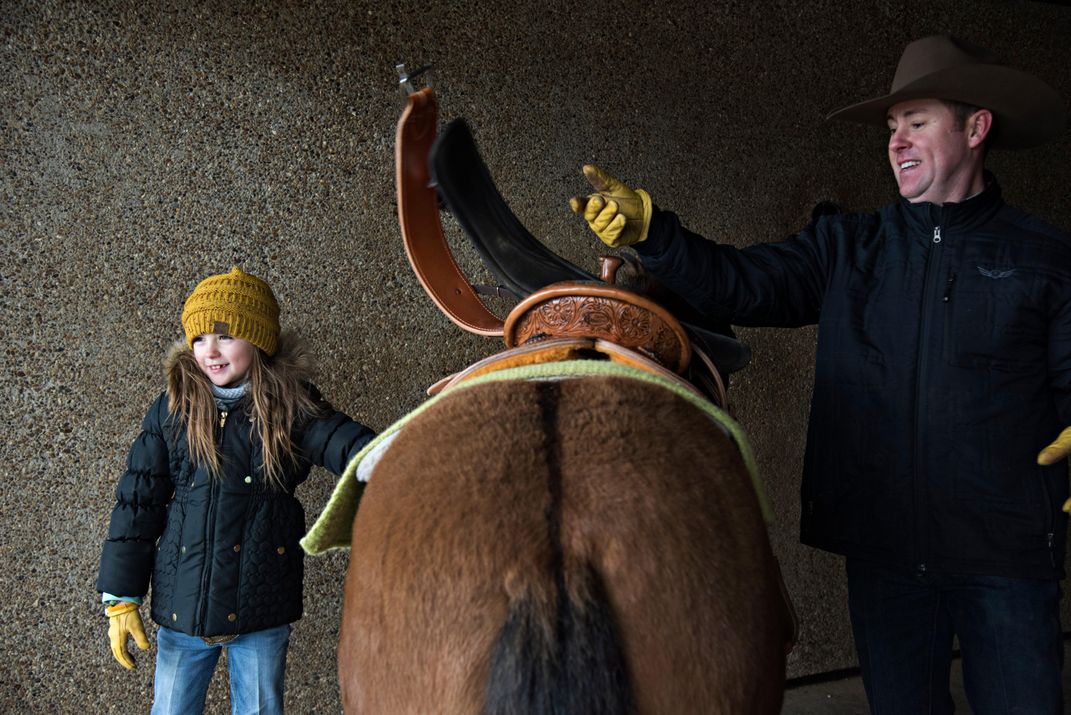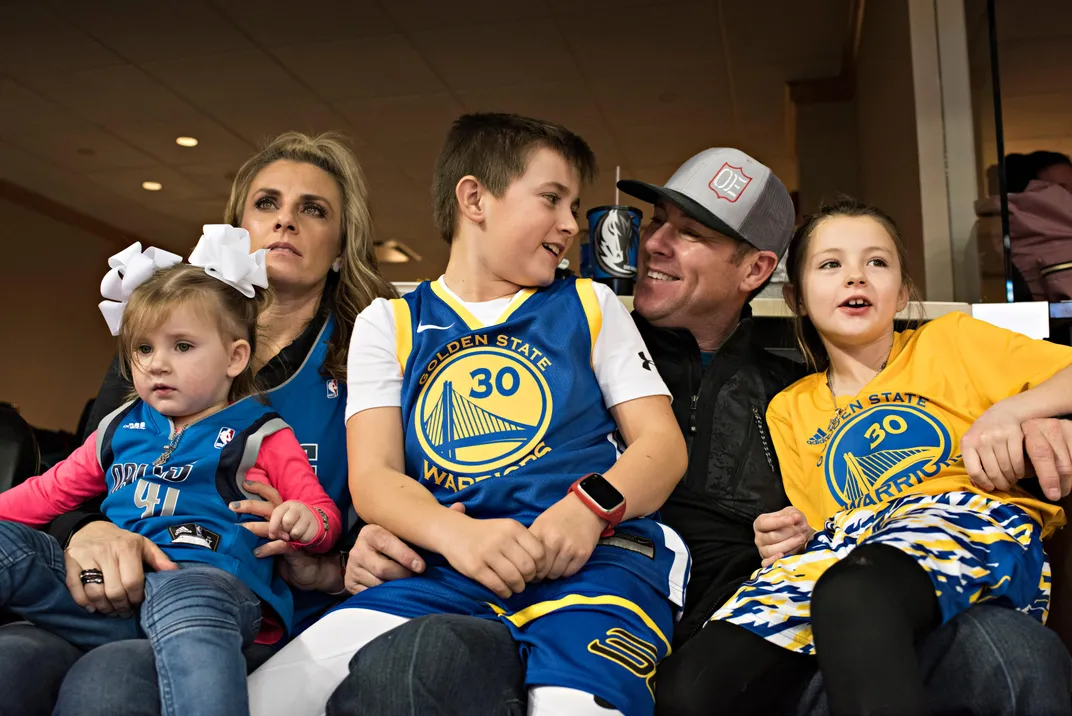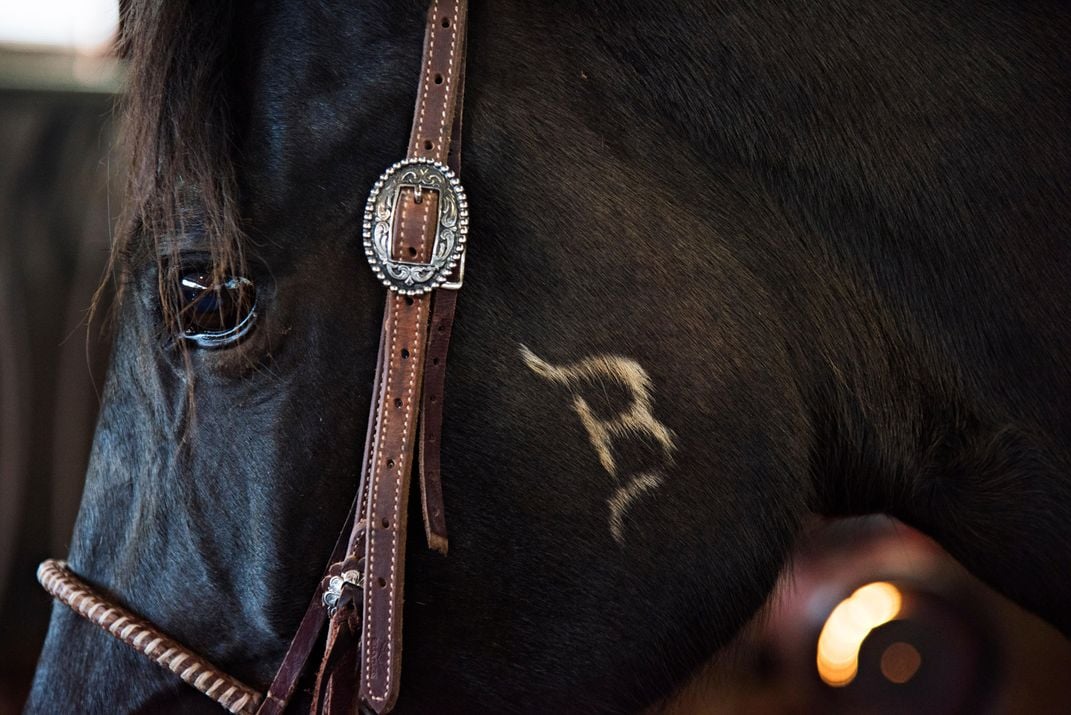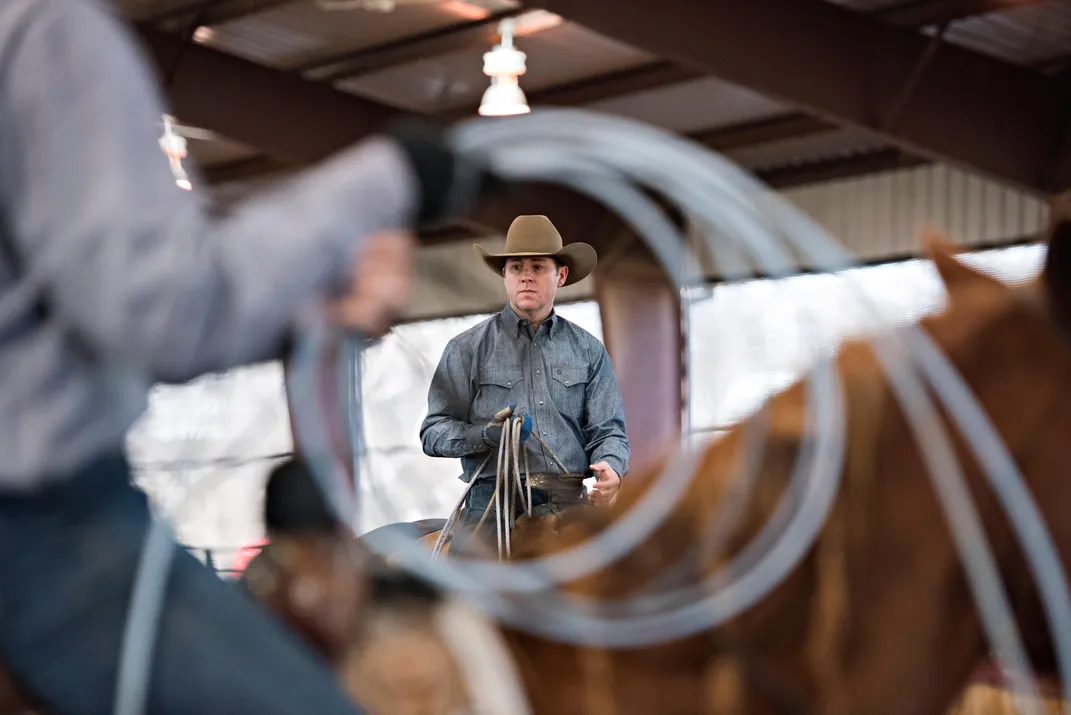An hour northwest of Dallas, Texas, the king of the cowboys is practicing for the richest rodeo of the year—ten days of high-stakes competition that will make or break his season.
His name is Trevor Brazile. He is a modest man of 41, a prodigy in autumn, with boyish dimples, an eroding jawline, the compact physique of a hockey player, 5-foot-10 in his roomy, square-toed cowboy boots. Raised on a feedlot in the dusty Texas Panhandle, he roped his first calf from horseback at age 3; at age 5 he refused to return to the second day of kindergarten unless his parents installed his roping dummy on the school playground. Over the past two decades, Brazile has won more pro-rodeo championships, 23, than any other cowboy in history. Going into the Wrangler National Finals Rodeo in Las Vegas, Nevada, known as the NFR, he’s once again leading the all-around standings—though not by much. Putting it mildly, as people like to do in these parts, it’s been a challenging couple of years.
Brazile’s 100-acre ranch is nestled into rolling, winter-brown hills a few miles outside the town of Decatur. Bare trees rise sculpturally toward a wan blue sky. Brazile and his crew are busy inside an immense, roofed-in practice pen, down the slope from his big stone house. He’s been working out all afternoon. The evening chill is beginning to settle. The overhead lights are on. The dirt is red and fine, a sandy loam. Frank Sinatra is crooning “Fly Me to the Moon” from built-in speakers. The playlist belongs to Brazile’s practice partner, 28-year-old Tuf Cooper, who will also compete at the NFR. As it happens, Tuf’s dad is ProRodeo Cowboy Hall of Famer Roy Cooper, who mentored Brazile when he was coming up. Tuf is currently second in the all-around, just behind Brazile—the young buck nipping at his heels, just as Brazile once did with Tuf’s dad.
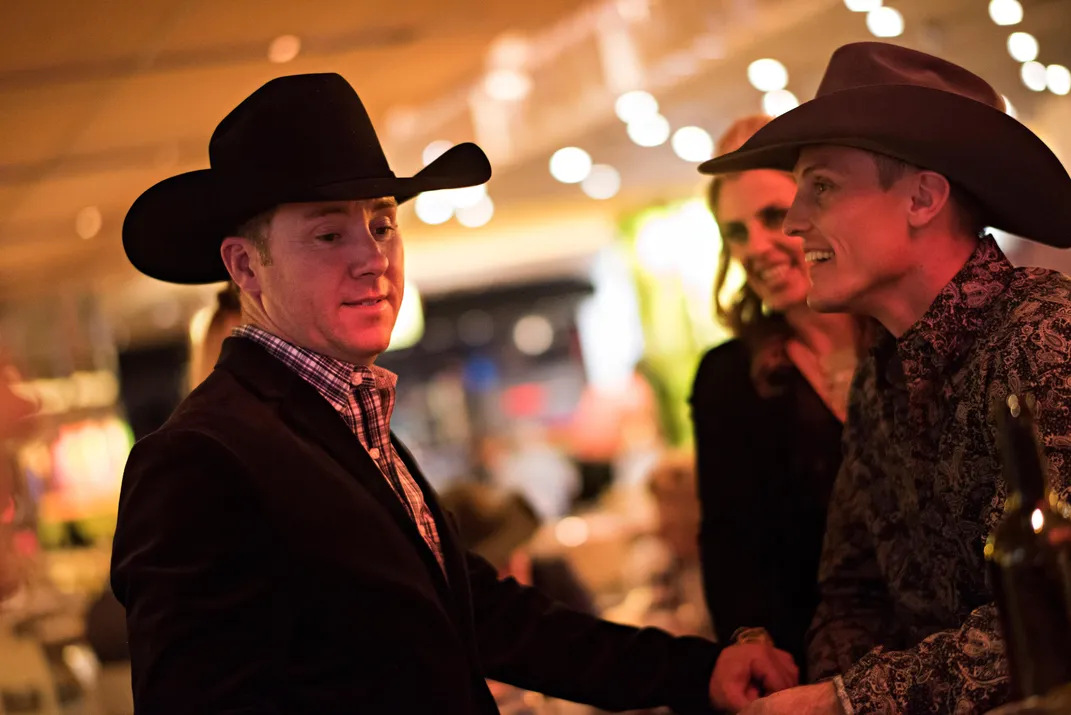
At the moment, Brazile is in the starting box, seated on a handmade saddle strapped to his calf horse, Deputy. Brazile uses a different horse for each of the three events in which he competes; the others are stabled next door. Versatility is one of the main reasons he’s been all-around champ 13 times. He’s also won titles in ten individual events. Championships are based on year-end aggregated earnings. Few cowboys are good enough to compete at this level in more than one event. And few have the will to hit the quota of 75 to 100 events in each category that are counted toward earnings totals. The rodeo season lasts nearly year-round: The old season ends on September 30 and a new one begins October 1. This past summer, over one six-day period, Brazile and a helper drove 7,500 miles and hit five different rodeos.
Brazile has altered the box with plywood to mimic the facilities at the Thomas and Mack Center in Las Vegas, smaller than most rodeo venues. Likewise, temporary fencing has been brought in to downsize the ring. To Brazile, no detail is too small: Before he bought the ranch, he says, he took a shovel to every property he shopped—he didn’t want to have to haul in the kind of soft dirt that is easy on livestock. “I may not be 6-4 or 225 like some of the competitors, but I don’t cheat the process,” he will later tell a Vegas crowd at a meet-and-greet.
Deputy is a 15-year-old sorrel gelding with a fancy braided tail and mane—you don’t want to rely on a young horse at a critical time. Both horse and rider are dressed crown-to-hoof in Brazile’s signature clothing and tack, brand named “Relentless”—a handle suggested by one of his business partners but pretty much on the nose. Deputy sports a Relentless breast collar, bridle, saddle pad, and fetlock and hoof wraps. A full line of roping supplies, including practice dummies, is also available.
Brazile’s hat is a black Trevor Brazile signature 100X by Resistol, the Texas-based company that sells a million hats a year. The rest of Brazile’s outfit is Relentless, licensed by cowboy performance-wear giant Ariat to Brazile’s specifications: The shirts have extra room in the arms and chest for roping and wrangling. The jeans material, unlike traditional denim, is stretchy for comfort and movement, but can still stand dry-cleaning chemicals and hold a crease, the look pro cowboys prefer. The boots feature rubber tread inserts for better traction, which help considerably in events like tie-down roping—Brazile’s signature event—where the cowboy, after roping the calf, jumps off his horse, sprints to the animal, then picks it up and throws it down onto its side (legs facing away) and ties three of the hooves together.
Brazile fiddles with his rope and loop, ready for his next practice run. Nobody ever calls it a lariat. Thirty-one feet long, it is woven of a special poly-grass fiber that doesn’t stretch. The material is known to become finicky in different types of weather and humidity. For this reason, cowboys carry special, doughnut-shaped, waterproof rope cans—with a strap for shoulder or saddle horn—that they guard somewhat jealously, like a woman does a purse.
He holds his right arm out from his body, elbow bent, hand at shoulder height, palm-forward, the loop supported by a single finger, the index, giving the impression that he’s gesturing thoughtfully, Wait a second or I’ve got an idea.
Coiled between his teeth is a piggin’ string—it’s written with the apostrophe. About six feet long, custom made of little-boy-blue, three-ply polyester rope, it is used to make the tie on a calf. To lubricate the slipknot, Brazile uses baby powder. It must be Johnson & Johnson original formula, nothing else. The smell evokes thoughts of his three young children, ages 11, 9 and 2, a strong sensory contrast to the rest of the immediate atmosphere—earth and manure, wood smoke and hay, sweaty men and animals. When he bites down on the piggin’ string, Brazile’s dimples show, making him look intense yet also elfin—he is the kind of guy who loves hanging out with his fellas and goofing, even as his eyes are darting toward the next task on his ever-growing list. To keep things tidy, the loose end of the piggin’ string is threaded through Brazile’s back belt loop. Another long rope, connected to Deputy’s bridle, is tucked in loops beneath his belt.
Deputy’s ears crane forward. His nostrils flare. Brazile nods his head gravely, causing the brim of his hat to bob. One of the crew jerks a lever, releasing the first in a line of 3-month-old calves, standing rump to face in the confines of the metal chute. Each weighs about 250 pounds. Owing to his strict protein and vegetable diet, Brazile goes about 185.
The first calf is a black baldy: black body with a white face. She’s the daughter of a calf Brazile roped at the 2015 NFR, the last time he competed there, and also the last time he won the all-around. To commemorate that victory, he bought the winning calf. Once known by her ear tag, #76, she is now a permanent resident of Brazile’s pasture. His kids named her Sally.
Sally’s daughter has no name, but like her mom she’s fast out of the gate.
Brazile and Deputy give chase.
***********
From Brazile’s practice pen, you can look over yonder on the hill, behind the lake, and see Roy Cooper’s 20-acre spread, with its own barn and practice pen.
Born to a famous rodeo family, Roy Cooper was one of the first great modern rodeo champions. He was known as “Super Looper.” He could rope left-handed or right. He sometimes flew to competitions and borrowed an unfamiliar horse. Over the course of his career Cooper qualified for the NFR 20 times. He won eight world championships.
Rodeo came to the New World with the conquistadors, along with horses and cattle. The word comes from rodear, Spanish for “to surround” or “encircle.” Long before professional cowboys were competing for brand sponsorships and five figure purses, ranch hands were competing for pride and amusement across northern Mexico and the American West. By the second half of the 19th century, public rodeo spectacles were popping up in nowhere towns like Deer Trail, Colorado, Pecos, Texas, and Prescott, Arizona. In the absence of movies, theater or sports teams, rodeo was the ascendant form of public entertainment across much of the great agrarian nation.
Like all great American pastimes, rodeo eventually became a big business. Cowboy associations sprung up; promoters and competitors got together to more or less standardize rules, regulations and titles. The first National Finals Rodeo was held in Dallas in 1959. For many years it was in Oklahoma City. It moved to Vegas in 1985. The sport’s governing body, the Professional Rodeo Cowboys Association, PRCA, holds the largest chunk of the game in its hands, sanctioning over 600 rodeos a year in North America and more around the world. Every rodeo event has an entry fee, paid by the cowboys. There is no guaranteed money.
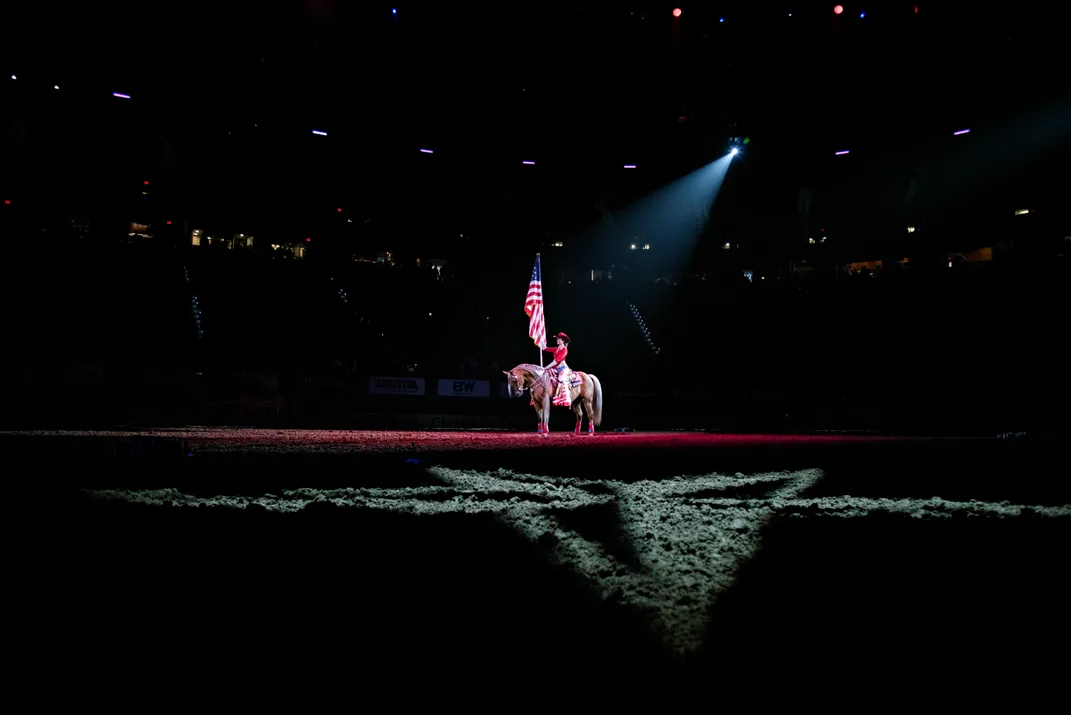
Typically, a rodeo features seven events, most of which are derived from necessary jobs performed on a cattle ranch. Bareback riding and saddle-bronc riding come from the practice of breaking wild horses for everyday use. Steer roping—also known as steer trippin’—in which the steer is roped by the horns and jerked off its feet, was used to doctor or attend to livestock, as was calf roping, Brazile’s only event at this upcoming NFR. For steer wrestling, the cowboy jumps off his horse, grabs the animal’s head and horns, and takes it down to the ground. (In days past, cowboys would also bite the animal’s nose or lower lip to help gain control. That is no longer practiced.) Team roping features two cowboys—one ropes the head and one the hind legs. In places where families have the space and wherewithal, team roping is practiced as a recreational sport, kind of like doubles tennis. There are tournaments, mixed and single sex teams, age groups, handicaps and purses. Barrel racing is the only women’s event regularly featured at PRCA tournaments; the contestants are still called cowgirls, a reflection of the somewhat retrograde values that cling to the rodeo world.
There is no possible reason one might need to ride a bull, rodeo’s most popular event. (In the riding events, the broncs and the bulls are also scored and rewarded championships and money.) Bull riding draws mostly young competitors who tend to have short careers due to injury—they alone wear protective vests and neck collars and sometimes helmets instead of cowboy hats. Some say the genesis of bull riding involved lots of boredom and alcohol.
From the mid-1970s to the late 1980s, Roy Cooper, a national high school and college champion and PRCA rookie of the year, was the most recognized figure in professional rodeo. “At his prime, he had no competition,” says Joe Beaver, an eight-time NFR champion roper and one of Roy’s many traveling partners, who is now a TV commentator. “He was so consistent. He was so fast and so darn good. He rarely made any mistakes. What he could do in the arena was unreal. He’s probably the greatest roper that has ever been.”
During the cocaine-fueled ’80s and ’90s, the Super Looper also became well-known for his appetite for epic spending and partying, turning up everywhere with his best friend, the country musician George Strait. There are a million stories. Roy loves to tell them. In one, the pilot of a private jet puts the plane on autopilot for two hours so he can participate in a rousing game of strip poker at 30,000 feet with Roy and friends.
Another of Roy’s rodeo buddies was a part-time competitor named Jimmy Brazile. He was one of the few left-handers around—given the setup at most rodeo arenas, it was a handicap. Jimmy lived on a feedlot with his wife and young son, Trevor, in the Texas Panhandle town of Gruver. It was flat country with hardly a tree in sight. The lot held about 10,000 head of cattle, brought in about 90 days before slaughter to be fattened on corn and milo.
“Even blindfolded, you couldn’t mistake the smell of a couple thousand steers,” Brazile remembers. “Their constant bawling sounded like a swarm of bees.”
“If somebody ever said something about the smell,” Jimmy says, “I told ’em: ‘It smells like money to me.’”
In time, the family left the feedlot business and moved south to Krum, north of Dallas. Jimmy went to work for Peterbilt. His wife Glenda was a schoolteacher and coach—she’d competed in rodeos as a kid; often at the feedlot she’d ridden as a ranch hand alongside her husband, a city kid who’d come late to the craft when he began dating her in high school. From the beginning Trevor never wanted to do anything but rope and ride. By age 11, he was competing in local and regional rodeos. He clearly had a rare talent. “He’d win all the year-end saddles,” Jimmy says. “Most of the time he’d win his age group a year or two before he hit the top age limit, like he won ‘12 & Under’ at 10. He’d just dominate each age group as he went along and win the title every year.”
As a teenager, to help finance his competition and travel, Trevor broke riding horses and trained barrel racers. He also took out bank loans (co-signed by his granddad) to buy calves for roping, which he then raised for sale for a profit. He also sold the saddles he won in competitions. “I probably won 70 or 80 over time,” Brazile says. “I hated to let them go, but I couldn’t afford to be sentimental.”
When Trevor was 15, Roy told Jimmy to send him to one of his roping clinics at his ranch in Childress, Texas. A relationship blossomed between the boy and the old pro; later, when Trevor was a freshman on a rodeo scholarship at Vernon Regional Junior College, about an hour east of Roy’s place, he spent all of his free time at the ranch.
“I remember Trevor being like 19, and he’d come down to my arena and he’d be like, ‘What are you going to work on today?’” Roy says. “He was so interested and asked so many questions. I knew back then he had what it took. He practiced all day, every day.”
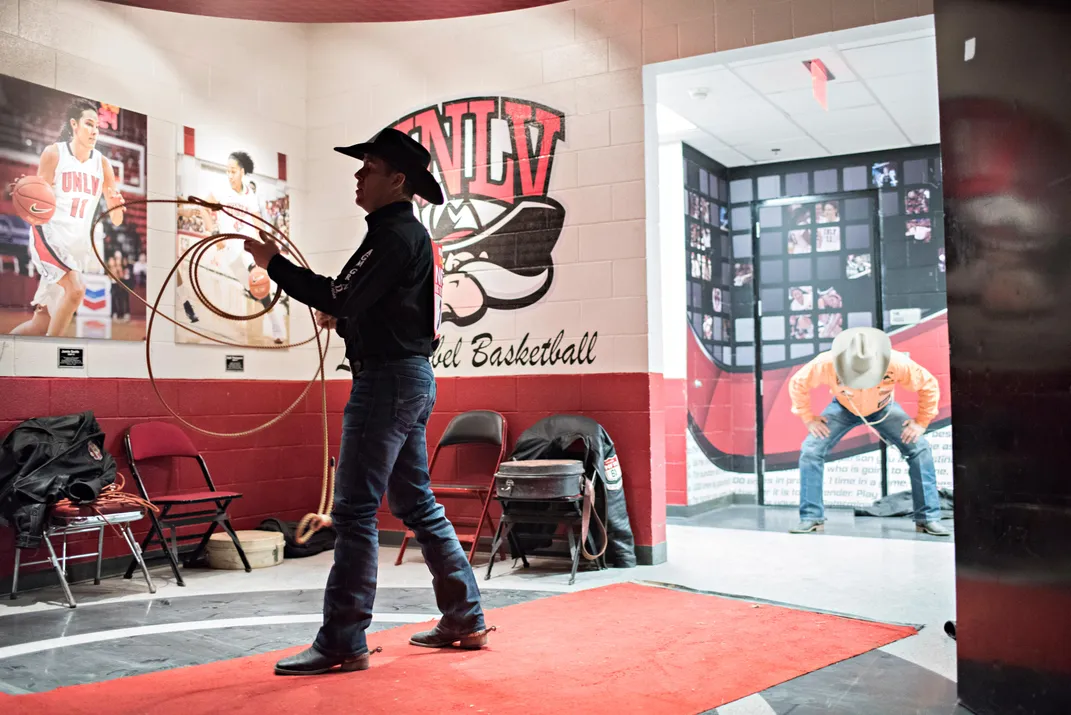
While Brazile was training with Cooper, he was also developing a relationship with Roy’s step-daughter, Shada, and his two sons, Tuf and Clif.
“My first memory of Trevor is when he brought me and my brother a bow and arrow,” says Tuf. “I was probably 6 or 7. I guess he was trying to get in with the little brothers right off the bat.”
Brazile went on to West Texas A&M University, but left in 1996, before graduating, to join the PRCA. He moved into an apartment on Roy’s ranch. During weekdays, when Shada was off at college on a barrel racing scholarship, Brazile would live in the house with Roy and with Shada’s mom, the former Shari Smith, and their two boys. Other times, he and Roy traveled together to rodeos.
“Trevor was so sweet to the boys,” says Shari Smith Cooper. “They played Lego like crazy, oh my gosh, they built stuff all over the house. They’d play guns, cowboys and Indians, baseball and basketball or football—they’d play and tackle or they’d wrestle, everything boys do. Then they would tie and rope and ride horses. Trevor became part of the family.”
Clif and Tuf—the stylized spellings are a Smith tradition—were 12 and 14 when their parents broke up, mostly due to Roy’s hard-partying ways. That same year, 2001, Shada and Brazile were married.
“A divorce is a rough time in a family’s life,” says Tuf, who stayed with the newlyweds for some time and was later home-schooled by Shada. “The care Trevor and my sister had for me and my brother made a huge impact. Trevor really guided me to do the right things. He didn’t allow me to go and screw up and do something extreme. I don’t remember a life without Trevor. I don’t remember him not being there for me.”
The following year, Brazile won his first all-around championship, followed in the next two years by his second and third. After narrowly missing in 2005, he won the next ten in a row.
************
For two weeks every December, when the rodeo is in town, Las Vegas becomes a celebration of all things western—even the huge golden lion in the lobby of the MGM Grand wears a cowboy hat. Up and down the Strip are bucking bronc and bull sales, barrel riding competitions, cowboy concerts and cowboy comic shows.
Dubbed the “Super Bowl of Rodeo” by the local paper, the Wrangler NFR is really more like Mardi Gras—instead of one game, the competition spans ten performances over ten nights. The NFR brings together, in each of its events, the top 15 money winners from the regular season. All of the men and women are fan favorites, the all-stars of their sport. Seven events are featured—there’s not enough room at Thomas and Mack for steer trippin’.
Sponsors like Wrangler, Polaris, Justin, Dodge and Coors flock and spend. An affiliation with rodeo is an affiliation with the spirit of the American Western ideal—a largely white, rural and Christian vision of a world where people are homogenous, neighborly and don’t overshare. They’re tied to the land. Treat animals as a valuable commodity that require care but not equality. Plan to meet again in the afterlife. Use liberally the affirmatives Yes, ma’am and Yes, sir, having grown up under threat of a stiff switch. At the Cowboy Christmas show at the Las Vegas Convention Center, a random rack of bumper stickers, displayed innocuously beside a booth selling knickknacks, provides a decent read on community values: I STAND WITH TRUMP. NO WELFARE FOR ILLEGALS. PETA: PEOPLE EATING TASTY ANIMALS.
On day eight of the finals, in the early afternoon, Brazile is riding in a hotel limo, after a meet-and-greet with fans at a big roping tournament at a hotel off the Strip. The leather seats are soft, the color of butter, as is the plush pile carpeting, atop of which are resting his black ostrich boots. Brazile’s cutter-style, double-mounted spurs were handcrafted by a well-known artisan from the drive shaft of a Model T. He wears them everywhere, jingling as he goes.
The autograph line at the last event had snaked around a corner. There was a giddy, expectant air among the pilgrims. More than two decades ago, when Brazile first broke in, many of them were children. Now they were bringing their own children to meet him. Each fan lingered beyond the signature, to spend a few moments chatting, to bask in the presence of the king. They brought up personal matters: a problem training a stubborn horse; a son or daughter’s promising career in junior rodeo; a local connection to a distant family member; a question about horses or roping technique. After each audience came the selfie. Whole families arranged themselves around him; without prompting, Brazile put a snotty toddler on his knee.
As required for official events, Brazile is wearing his uniform—a black hat and blue jeans and a black shirt embroidered with sponsors’ logos. Traditionally, winners’ purses include swag: finely crafted gold belt buckles, fancy hand-tooled saddles, watches, gun cases, spurs and sculptures. Brazile has won so much stuff he’s given it to a local merchant at home in Decatur to catalog and enshrine. The belt buckle he’s chosen to wear this week says 2015 World Champion All-Around Cowboy, the year he roped Sally, tying an NFR arena record at 6.5 seconds. It was the last he won before the end of his decade-long streak.
Before the 2015 Finals, many cowboys’ long-simmering discontent with the PRCA—about the brutal travel schedule, threats to eliminate events, and inadequate, non-guaranteed payouts (only winners get the purse, but the PRCA takes a cut)—came to a head when Brazile and a group of 80 top competitors formed a parallel body called Elite Rodeo Athletes, the ERA. Shortly thereafter, the PRCA passed bylaws barring ERA cowboys from entering their events, including the NFR. The ERA, in turn, filed an anti-trust suit in federal court.
When the dust cleared, the ERA cowboys and cowgirls dropped their lawsuit. Brazile, Tuf Cooper and many others sat out the 2016 season, opting to participate only in the nine, ERA-sanctioned rodeos and a smattering of other independents—none of which qualified them for the NFR, which is by far the most lucrative rodeo in the world. Brazile also lost his endorsement deal with Wrangler, PRCA’s premier sponsor. A line of children’s clothing, conceived and run by Shada Brazile, was also discontinued.
During his enforced layoff, Brazile says, he “spent a lot of time going to the batting cage with the kids and working on my 3-point shot.”
“It was different,” Shada says. “We kind of had a normal schedule. We went to weddings and birthday parties and stuff we’d always missed. I kinda liked being home. I got used to it.”
Returning to competition at the beginning of this 2017 season, Brazile says, “I felt rejuvenated. As much as I’ve invested and loved this sport, a year off gives you that extra oomph. You just crave it that much more.”
Even so, his performance through the regular season was underwhelming. The rust was thick. “It was the first sub-$500,000 year I’ve had in a long time,” he says.
More troubling: Brazile’s earnings from sponsorships far exceed his rodeo earnings. Currently, he endorses or licenses hay, feed, saddles and tack, ropes and roping gear, trucks, trailers, customized living quarters in trailers, off-road vehicles, a performance supplement company, the clothes, and more. Seemingly nothing he uses on his ranch isn’t supplied for free by some sponsor; winning is necessary to keep the juggernaut afloat. Born poor and lifted by his own bootstraps, Brazile is acutely aware of the value of his name and brand: It’s what enables him to compete more often and in more events than other cowboys, and to afford to travel farther to do it.
“There’s a lot of winning that didn’t get done this year, that normally did,” he says, shaking his head. His hat weighs down on the tops of his ears, folding them forward a bit, adding a suggestion of youth and earnestness.
************
The final night of the Wrangler NFR is the money shot, Vegas in full Western reveal: cowboy boots and lace, turquoise and rhinestones, plaid and denim, the air flavored with anticipation and barbecued beef, country-western hits booming from the PA system outside the Thomas and Mack Center. Traffic is snarled. Search lights sweep the sky. Tickets officially run $67 to $300, but many have paid thousands for their seats. Over ten sold-out days, 171,000 people will attend the rodeo.
It takes 2,000 tons of dirt to turn Thomas and Mack, more universally known as the pro-style basketball arena at the University of Nevada at Las Vegas, into a rodeo venue. Anyone meaningful to pro rodeo is here for the final night. The members of the extended Smith-Cooper-Brazile clan, more than 50 in all, are scattered throughout the building. Shari Cooper has a seat next to the starting box. Shada also has a plum seat. Her daughters with Trevor—Style and Swayzi—are dressed in matching gold sparkle dresses with white faux-fur capes. Their son, Treston, looks like a miniature man in his sport coat and tan Resistol hat.
Going into the NFR after the rough regular season, Brazile had felt better than he had all year. “I was finally feeling like myself again,” he said.
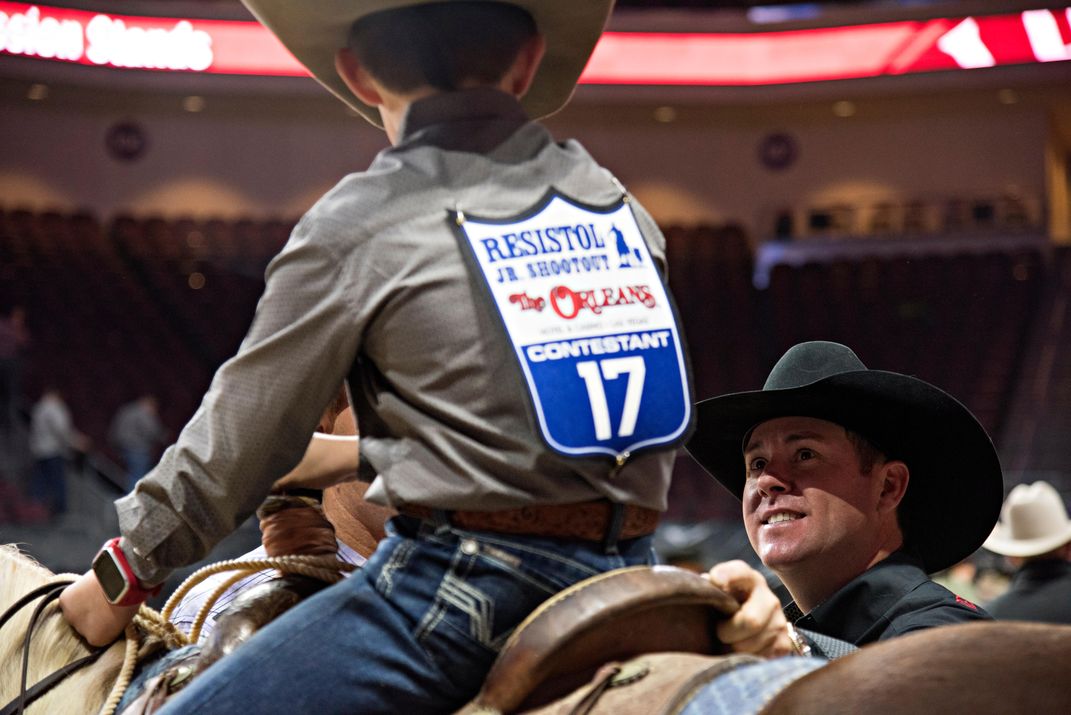
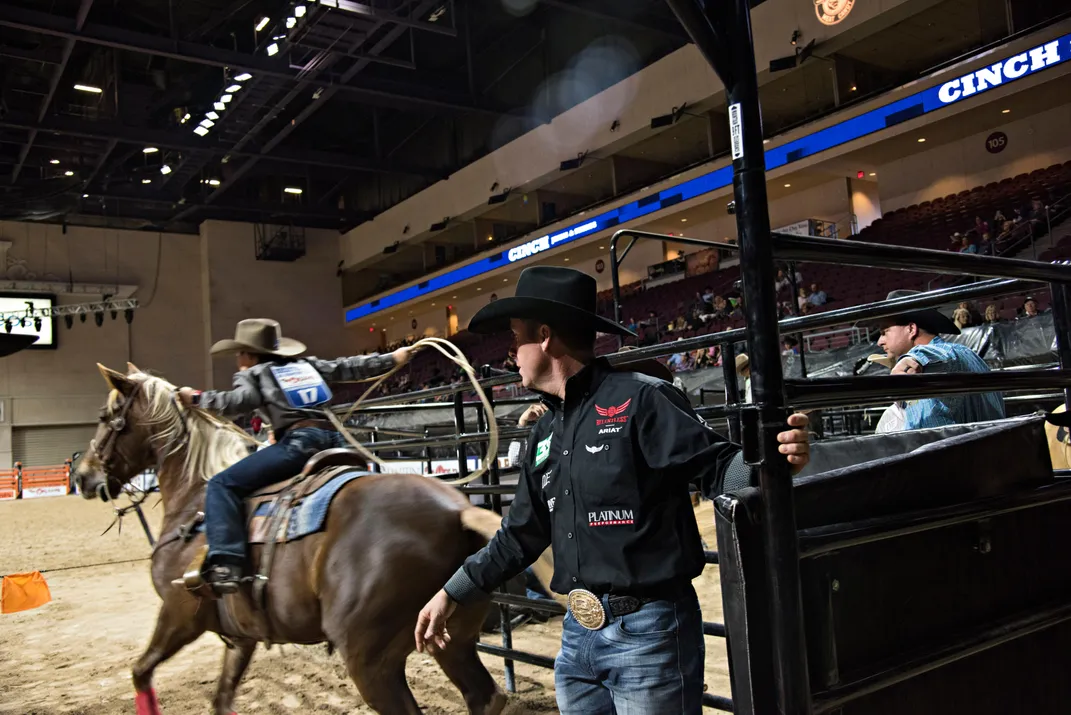
In round one, he tied for second place (7.9 seconds). In round two, he placed first (7.4). In round three, he was third (7.3). At that point, the king of the cowboys was leading the all-around with $313,837. And he was leading all contestants for lowest average time in the event, which pays another $67,000 at the end of the meet and counts toward the all-around totals. It appeared he was finally back on his game.
Then things began to unravel. The NFR is a marathon. Along with the strain of nightly competition, there are daily appearances and autograph signings, post-rodeo dinners with sponsors, and late-night partying with family, friends and fans.
Brazile tied for eighth in round four (9.4) and finished eleventh in round five (10.4).
In round six, when he desperately needed to get things back on track, he was disqualified for a “jerk down,” meaning Deputy pulled back too hard on the rope after Brazile dismounted to chase the calf, a rule installed to accommodate animal rights advocates. Family and friends were aghast, citing the call as evidence of the PRCA’s sour attitude toward their fallen poster boy—a revenge play for his ERA rebellion. A jerk down call on night six? It was like fouling out Michael Jordan from a finals game.
Last night, round seven, the bottom fell out.
“After I got flagged out for the jerk down, I knew I was out of the average competition, so I came back knowing I had to press for day money,” Brazile would later say, his tone neither grim nor heroic, just matter-of-fact. “I backed myself into a corner. I had a predetermined shot. Do it or fail. Anybody I’m teaching, I tell them: You can’t rush, you can’t press. There’s a lot of elements to bring together for a good run. The calf, your horse, yourself….”
Brazile missed the throw completely.
The crowd of more than 16,000 went silent.
Unfettered, the calf gamboled across the dirt ring and disappeared through a gate.
“It was ugly,” Brazile said.
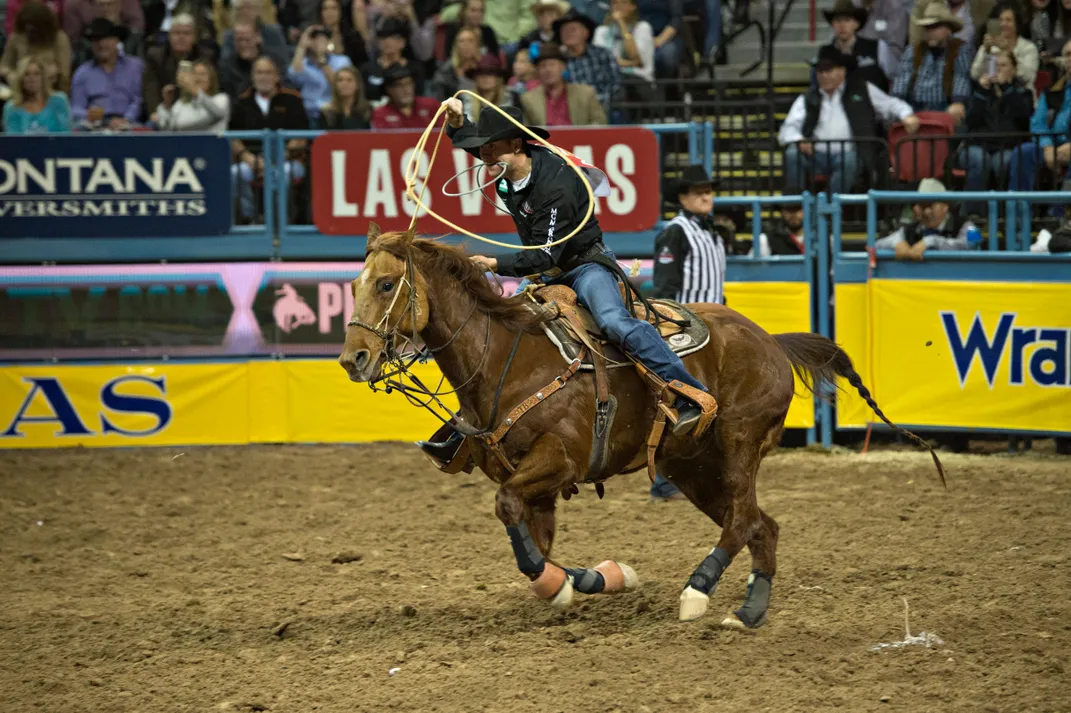
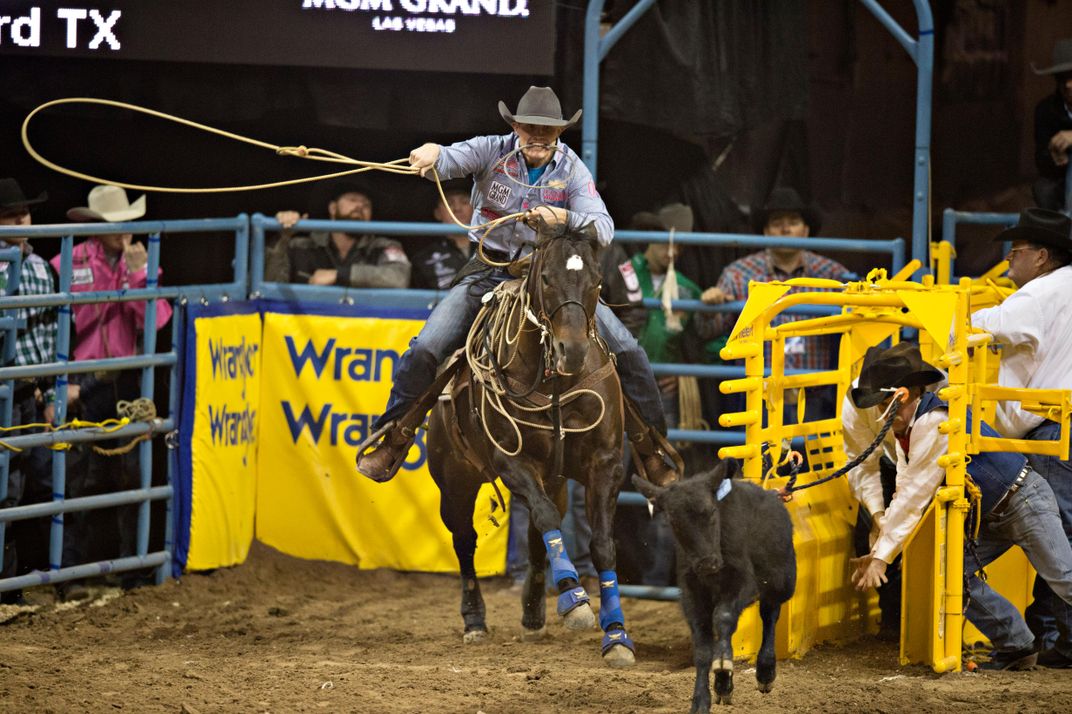
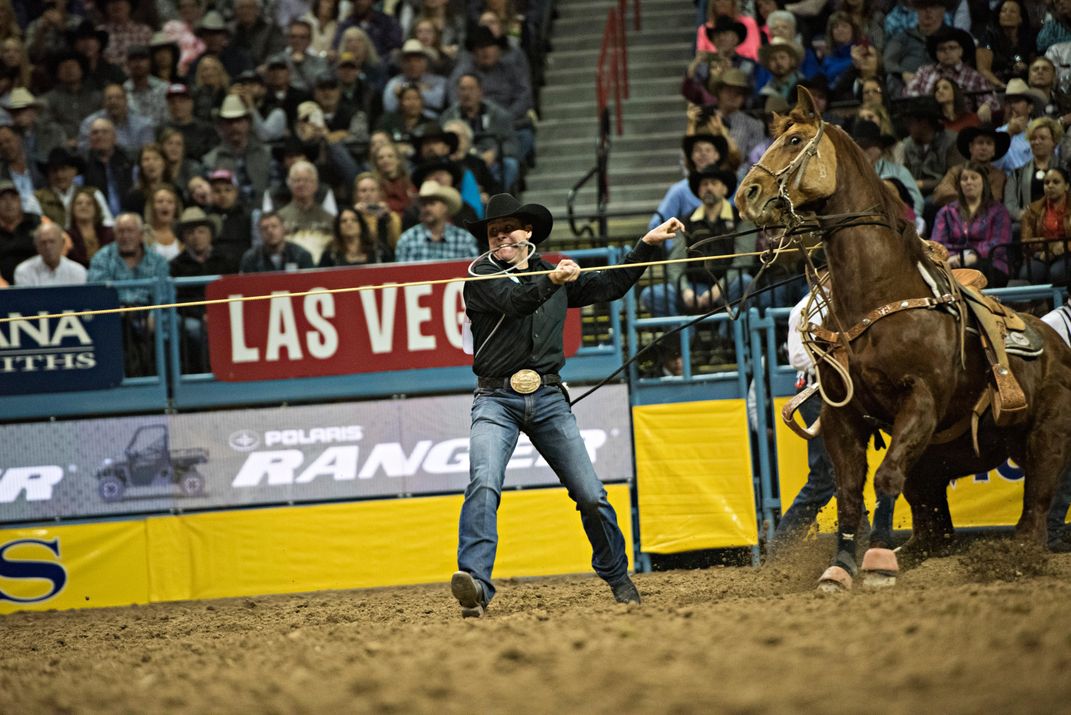
************
Going into the tenth and final night at the NFR, Brazile is still leading Tuf in the all-around, $319,337 to $286,983, a difference of about $32,000. But after a strong comeback over the last few days, Tuf is first in tie-down roping. And he’s second in the average. Though Tuf hasn’t performed spectacularly, he’s been consistent—you have to post all ten scores to qualify for average money.
Brazile is the tenth contestant to take his turn. Tuf will go last.
Brazile rides Deputy into the arena. The spotlight shines. The announcer intones dramatically:
“Two decades ago, he was winning college championships. Twenty years later, he’s the winningest cowboy in professional rodeo!”
The crowd roars.
“That’s right, people, THE Trevor Brazile! Six million dollars of winnings! Twenty-three world championships!”
In the stands, Shada’s brow furrows. Man, she thinks, no matter who wins, I’m a winner tonight, and I’m a loser tonight.
Brazile sets up Deputy in the starting box, worries the rope into shape, holds his right arm out from his body—the same crooked elbow, the same single index finger pointed up, the same dimpled bite on the piggin’ string. To win his 24th championship, he needs a first place finish. The time to beat is 8.1 seconds. It’s win or go home.
Uncharacteristically, Brazile looks nervous and unsettled. He swings Deputy around and repositions him. He fidgets in the saddle. He fixes his hat. He plays with the piggin’ string, setting it properly in his mouth.
At last, the dimples show. He nods his head gravely, causing the brim of his hat to bob. Deputy is the fastest calf horse he’s ever owned. Brazile never even has to kick him. Usually, as soon as the chute opens and the calf bolts, and Deputy feels the tension come off the reins, he is running full speed. This time, when the chute opens and the calf bolts, Deputy rears up a bit, both front legs in the air, a sprinter out of form. A few microseconds of eternity pass. Finally, Deputy gives chase.
Brazile swings his arm, once, twice, three times, Deputy’s hoofs pounding the sandy loam, the loop circling his head. Then he throws overhand, a unique motion said to share kinship with a baseball pitcher’s follow-through. As the loop settles around the calf’s neck, Brazile jumps out of the saddle and runs full speed toward the stunned but still-standing bovine.
Meanwhile, Deputy stops in his tracks, and begins walking backward, as he’s been trained to do (horses don’t naturally back up). The other end of the rope is attached to the saddle horn. When the calf runs out of slack, it’s jerked backward somewhat violently—hence the jerk-back rule. Animal rights proponents claim the calves get hurt; cowboys say they are professionals and wouldn’t ever want to injure the animals on which their livelihoods depend.
Brazile grabs the rope’s “hondo” (the slipknot) with his left hand. With his right, he grabs hold of the calf’s flank (the fleshy portion between the rear leg and the belly). In one strong motion he picks up the animal—older and larger than his practice calves, 100 pounds heavier than himself—and takes it to the dirt.
Straddling the calf, Brazile gets the slipknot over its front hoof, then gathers the two back legs—sinuous, strong, uncooperative. Many a fast run has been ruined by a stubborn leg.
Two wraps, pull the loop through: a hooey knot. A bouquet of cloven hooves.
Brazile throws his hands in the air like a gymnast finishing a landing—the signal to stop the clock.
The official time blinks on the scoreboard: 9.9 seconds.
His season is over.
************
When the last competition is over, the house lights in the Thomas and Mack Arena are dimmed. It’s time for the Gold Buckle Ceremony.
Spotlights are trained on a small platform in the center of the ring, which has been filled with theatrical smoke. The platform is crowded with rodeo brass and legends. Around the circumference are nine elaborate, hand-tooled trophy saddles, one for each event (team roping has two winners) plus the all-around.
One by one the victors are called. They come out holding their gold buckles, accompanied by flashing lights and a heavy metal soundtrack. It’s reminiscent of an entrance you might see in pro wrestling, only foreshortened for lack of space. Last up is the winner of the all-around, Tuf Cooper.
Tuf won his first roping contest at the age of 6, turned pro at 18. At 23 he became the youngest cowboy ever to reach $1 million in earnings. In 2010 he was joined in the NFR tie-down roping competition by his brother Clif and his step brother Clint, Roy’s son by his first wife—the first trio of brothers to ever compete in the same NFR event. With his baby face and cherubic smile, the name of his Lord and savior embroidered along with his sponsors across his uniform shirts, Tuf’s been called the “Justin Bieber of Rodeo.” He has a large social media presence. His autograph lines are often dominated by middle-school-age girls. “Grandparents want girls to marry him, and daddies want their sons to be like him,” says Shari Cooper.
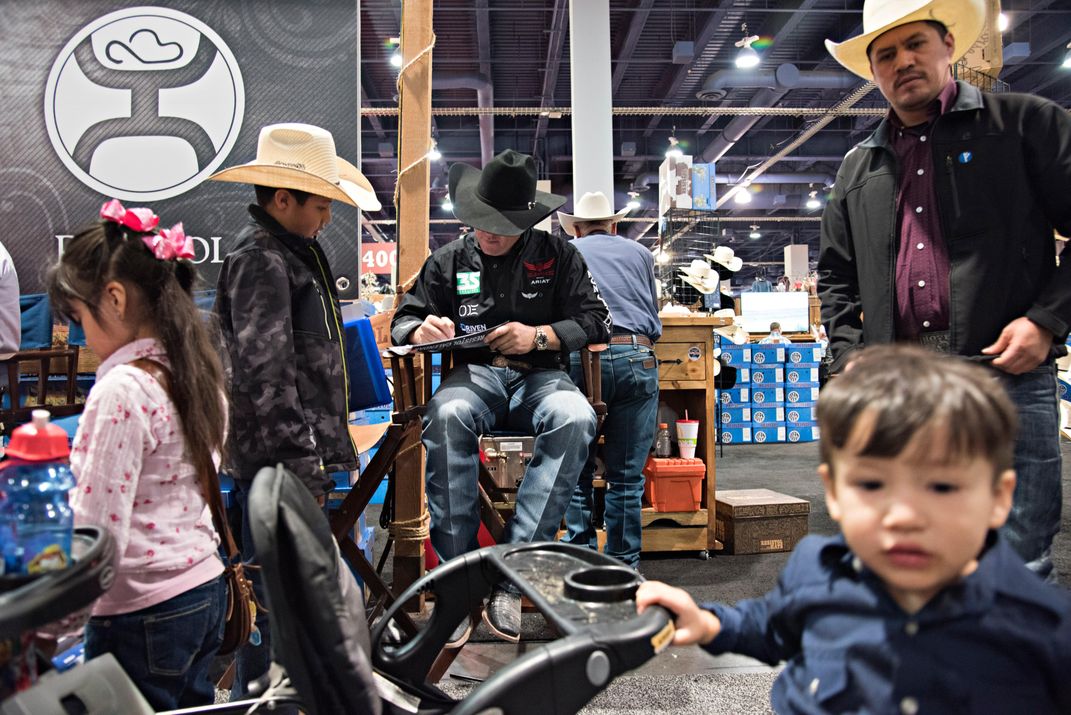
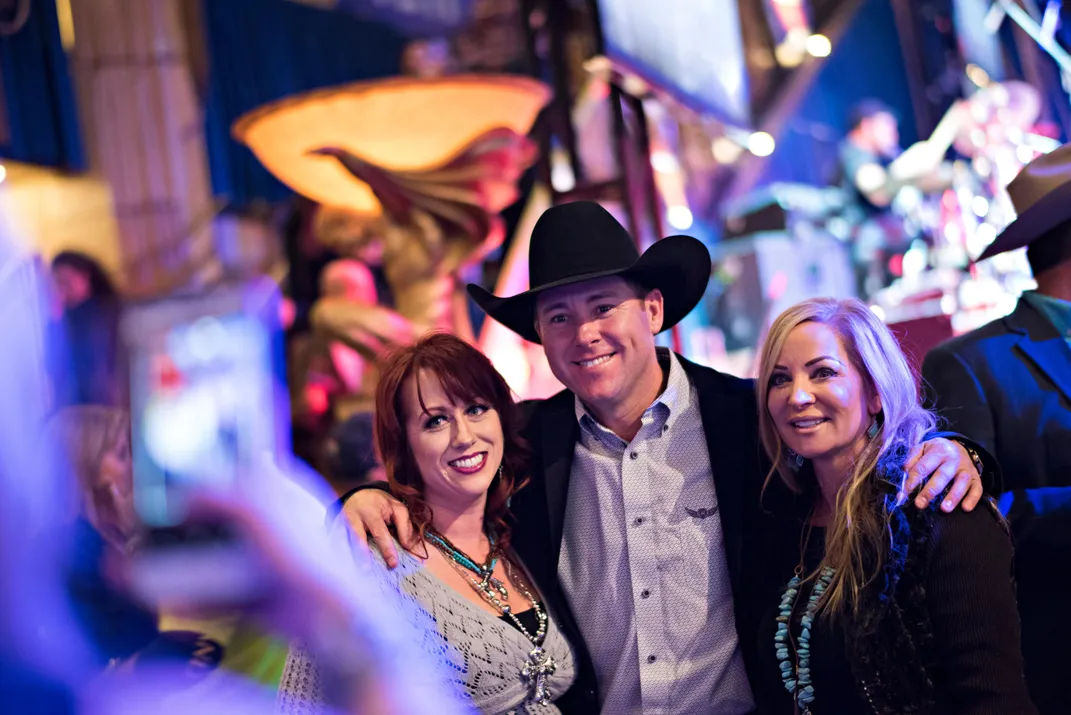
Unbeknownst to many, Tuf’s heart is reserved for his girlfriend, Tiffany McGhan, a fashion blogger and stylist. Tiffany is a few years Tuf’s senior. Tuf was 19 on their first date. He dressed in a sports coat and picked her up in a red convertible Mercedes, and together the couple completed a rare Dallas sports bifecta: attending both a Cowboys football and a Rangers baseball game on the same day. According to Shari, Tiffany has quietly and maturely endured the onslaught of teeny-boppers for seven years. Everybody is always asking when they will tie the knot.
Tuf strides toward the Gold Buckle platform to make official his first all-around title. He’s wearing a steel-colored American Brand hat. His blue gingham check shirt and his blue jeans are both “Tuf Cooper Performance” by Panhandle. His boots are light blue ostrich, custom-made by Rios of Mercedes.
As they’ve come to the stand, each winner in turn has been interviewed by the popular country music radio host Suzanne Alexander, who has anchored the TV coverage on CBS Sports for the past ten nights. Now Alexander sticks a microphone under Tuf’s strong jaw. Tuf smiles and reaches across his body with his right hand, taking hold of the mic jointly with Alexander. He tugs lightly, trying to gain possession of the mic. She doesn’t want to let it go. The cameras capture the moment up close in HD; it plays both at home and in the arena.
Tuf thanks Trevor Brazile, and also “my family, my dad, my brothers,” and all of his fans. Then he makes another attempt to wrest free the mic. “Susan, I have something special I want to do now,” he says.
She continues to hold on.
“I got this,” he says—this time somewhat pointedly, flashing one of those big Texas smiles that lets you know someone is gravely serious. At last she relents.
Tuf is all blue eyes and bone structure, his ears bent forward with little-boy earnestness beneath the brim of his hat. For one brief moment, professional rodeo’s newest all-around champion looks as if he’s about to cry. “Pretty nervous right now,” he says into the mic.
Then he takes off his hat, gets down on one knee and proposes marriage to Tiffany.
The crowd goes wild.
************
A few weeks later, back at home, Roy Cooper is hanging out in the den at his ranch, watching football and sipping on a Fireball mini. From the built-in couch where he’s lounging, beside a large window, you can see the pond. It has a fountain in the middle that wouldn’t be out of place in Vegas, throwing up a spout 30 feet high.
The way Roy figures it, there’s a beautiful symmetry to Tuf’s relationship with Brazile. “I know Trevor helps Tuf, but it goes the other way, too,” he says. “Just like Trevor probably helped me, because I seen how hard he worked at it, and it made me work a little harder, too.”
Roy looks out the window. He can see Tuf, the youngest of his three sons, and the newly crowned all-around champ, working out with his horse in his practice pen. Tuf has just returned from a celebratory trip with his new fiancée. There’s a rodeo in Odessa this weekend, and he needs to iron out the kinks.
Ordinarily, Tuf would practice with Brazile over at his place, but Brazile has already left for Odessa.
Before he drove off, Brazile raised his hat and wiped his brow with his sleeve. Then he looked thoughtfully into the middle distance, the way cowboys do.
“Plain and simple: I just didn’t perform good enough to win it this year,” he said. The sun was setting after a long day of practice. “I know I’m near the end. Sometimes, I feel like I need to find some inspiration to make it work, to keep pushing the way I always have. I don’t have anything else to prove.”
:focal(4693x2387:4694x2388)/https://tf-cmsv2-smithsonianmag-media.s3.amazonaws.com/filer/0c/49/0c4975b3-5ccb-4b7c-82a1-da7e701a12aa/20180104_smithsonian_trevorbrazile246-resize.jpg)
